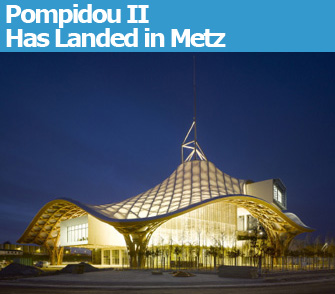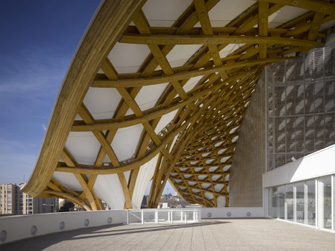 |
|
The new Centre Pompidou-Metz. © Shigeru Ban Architects Europe and Jean de Gastines Architectes / Metz Métropole / Centre Pompidou-Metz / Photo: Roland Halbe |
When you step out of the back of the Metz train station today, you are treated to the dazzling sight of what looks like a gigantic white spaceship recently come to earth. No, this is not Mars Attacks! all over …
 |
|
The new Centre Pompidou-Metz. © Shigeru Ban Architects Europe and Jean de Gastines |
When you step out of the back of the Metz train station today, you are treated to the dazzling sight of what looks like a gigantic white spaceship recently come to earth. No, this is not Mars Attacks! all over again; it’s the new Centre Pompidou-Metz, which opens to the public today.
While the architecture is eccentric and not always clearly readable, it is hard not to love this building, designed by Shigeru Ban and Jean de Gastines. The bentwood structure holding up the floaty white Teflon-and-fiberflass-covered roof (whose shape was inspired by a Chinese hat the architect Ban found in Paris) is graceful and simply beautiful, giving the building a feeling of lightness in spite of its size, as if it might indeed lift off and head back to Mars at any moment. And great care has gone into the quality of the building’s details, from the toilet fittings to the handsome restaurant with terrace.
The ceilings of the ground floor galleries open up to allow views of the spaces under the roof, lined in places with mirrors reflecting fractured views of upside-down artworks, visitors and the building’s structure. From other viewpoints, you see enormous white-painted ducts – surely an homage to the original Centre Pompidou in Paris, designed by Renzo Piano and Richard Rogers, with its famously exposed inner workings.
Each of the three upstairs galleries is a long rectangular box with glass walls at either end offering views of the city. The three boxes are laid on top of each other at different angles, and the whole is covered with the white roof (the ends of
 |
|
Detail of the roof. © Shigeru Ban Architects Europe and Jean de Gastines Architectes / Metz Métropole / Centre Pompidou-Metz / Photo: Roland Halbe |
two of the galleries sticking out from the roof can be seen in the photo at the top of this page). One glass wall in Gallery 3 offers a view of the Metz Cathedral, complete with a neat optical trick: when you are at the other end of the gallery, the cathedral looks huge, but as you walk toward the window, it seems to get smaller and smaller.
What’s inside the Paris Pompidou’s sister museum? The inaugural show, “Chefs-d’Œuvre?” (“Masterpieces?”, through Aug. 29), is a broad survey that asks the question, “What is a masterpiece?” without – appropriately – presuming to find an answer. Moving quickly from Antiquity to modern and contemporary art, it includes a bit of everything – painting, sculpture, video, installations, graphic arts, and design – and is generally beautifully displayed and lit.
What is most appealing about this presentation, perfect for a long afternoon’s perusal (it includes some 800 pieces, 700 from the Centre Pompidou’s huge reserve collection), is that it doesn’t include just the usual suspects; there are many lesser-known works by great artists and some works by lesser-known artists. Here is a copy of a striking tomb statue, attributed to Ligier Richier (c. 1500-67), from Saint Etienne Church in Bar-le-Duc, of an upright skeleton, its flesh falling off the bones, looking upward and holding its heart up to the heavens. A little later you come across Auguste Rodin’s brilliant “Balzac’s Bathrobe,” even ghostlier than the skeleton with no man inside the empty white garment. There are also many atypical paintings by familiar artists, including unfamiliar works by in jewel-like colors by Georges Braque and a painting by Pierre Bonnard, “L’Atelier de Mimosa” (1939/1946), with intense, un-Bonnard-like Fauvist colors.
I particularly appreciated the way the artworks were displayed in Gallery 2. Mostly large works, they could be viewed either up close or though horizontal openings in a wall, on the other side of which each work is documented by a graphic wall display including photos and texts. This type of presentation, which I have never before seen in a French museum (or elsewhere, for that matter), allows visitors to look at a work without the distraction of labels, then, if they so desire, find out more about it.
Gallery 3 offers lots of corners and niches where works can be appreciated in isolation or grouped with related pieces. “L’Orchestre” (1953), a wonderful semi-abstract painting by the music-loving Nicolas de Staël, for example, is hung in its own room, where a recording of “Le Marteau sans Maître” (1954) by Pierre Boulez provides the music that might have been produced by the orchestra in the painting.
It is hoped by all concerned that the new museum will have the desired Bilbao effect and make long-neglected Metz (pronounced “mess” in French) an attraction in itself. Now only one-and-a-half hours from Paris since the TGV (high-speed train) line to northeast France finally went into service a couple of years ago, the city is well worth a visit. Occupied at various times by the Celts, the Romans, the Huns, the Franks, the Nazis, etc., and bounced back and forth between France and Germany many times, the capital of the Lorraine has been scarred by many vicious battles, but still has plenty of architectural gems to serve as mementos of its checkered history, plus one brand-new one, just landed. This invader, unlike previous ones, is more than welcome.
Centre Pompidou-Metz: Open Sunday, Monday, Wednesday, 11am-6pm; Thursday, Friday, Saturday, 11am-8pm. Closed Tuesday. Admission: €7. Free admission for anyone under 26. From Paris, take the TGV to Metz (1.5 hours) from the Gare de l’Est. The museum is a short walk from the Metz train station. www.centrepompidou-metz.fr
Support Paris Update by ordering books from Paris Update’s Amazon store at no extra cost. Click on your preferred Amazon location: U.K., France, U.S.
Reader Colin Eaton writes: “Apropos the recent opening of Pompidou Metz: perhaps it is no mistake that it is pronounced “mess” in French! I traveled there from Paris Est by TGV last Friday (forgetting how expensive the TGV can be, I didn’t book in advance, so I paid €106). The train arrived at 2:02pm. After following big, colorful signs saying “MetzPompiodou,” I eventually realized that some, although visually similar, actually said “MetzVille.” I was going in the wrong direction! So, I turned around and arrived at the new museum at about 2:45. Being an architect, my first interest was the building. What frustrated me was the lack of context or grounding to the place. The genus loci seemed to be missing. Don’t get me wrong – this building is certainly an accomplished work. It’s simply that the original Pompidou is such a hard act to follow. Its architecture, place making and urban design, coupled with ideas of form and function, and what was at the time a rather shocking factory aesthetic in the center of historic Paris were seminal. This is not! My big gripe, however, is that I was greeted by signs saying, “Thank you for your patience,” and informing me of the length of the wait ahead of me: 4 hours, 3 hours, etc. Visitors were corralled between metal fences, and those who got tired of waiting were forced to do a double turn and squeeze their way back out. I waited in line, shuffling along for over three hours, before showing a young official my TGV ticket – the last train back to Paris was 18:55! She asked me to wait a moment and then came back and said it was not her problem. Disappointed, I left to get the train back to Paris without seeing the inside of the museum. It was a real shame that the opening of the Pompidou Metz, for me at least, descended into a Mess. Will I go again? Hmmm. I will wait and see.”
More reviews of Paris art shows.
Reader Reaction: Click here to respond to this article (your response may be published on this page and is subject to editing).
© 2010 Paris Update
Favorite